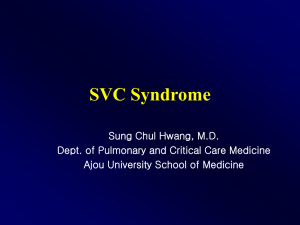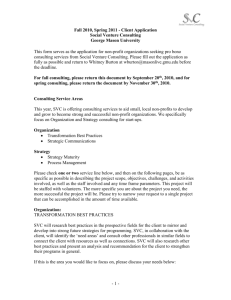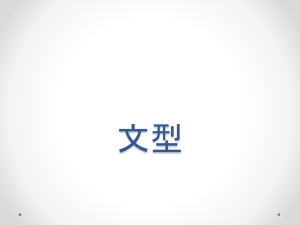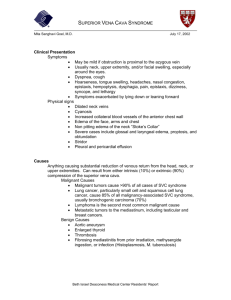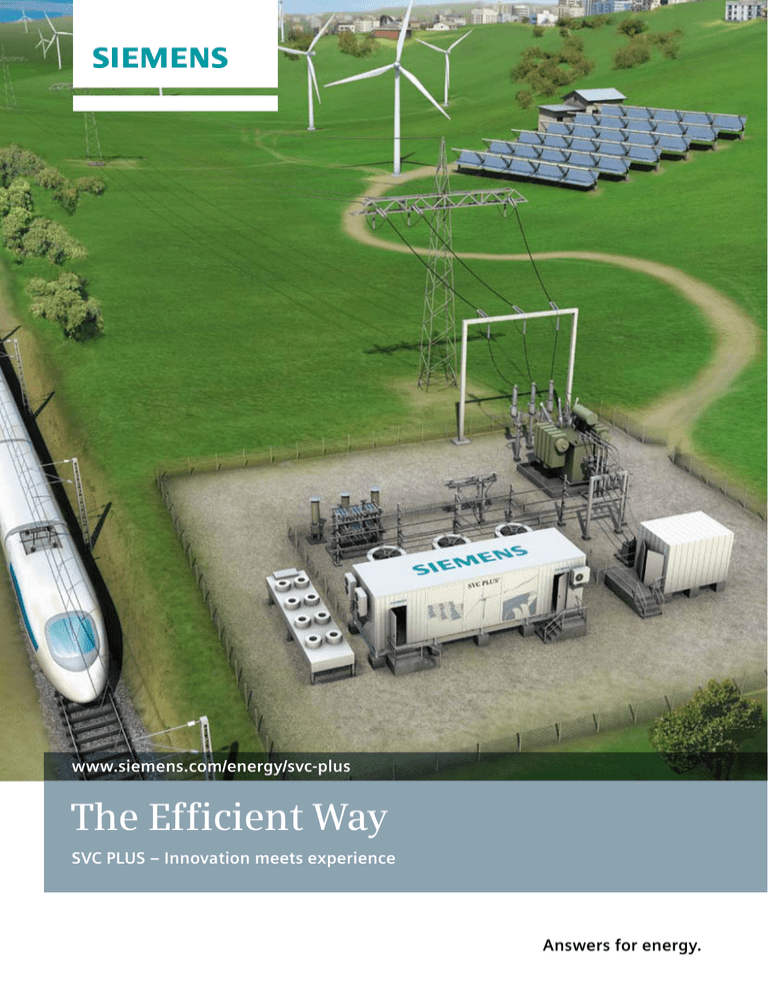
www.siemens.com/energy/svc-plus
The Efficient Way
SVC PLUS – Innovation meets experience
Answers for energy.
Enhancement of
Grid Efficiency
Improved dynamic stability and power quality of power systems
Fundamental changes are affecting the power industry. Markets are being
deregulated and liberalized, urbanization is continuing around the world
accompanied by a constantly growing demand for energy, and renewable
energy sources are playing an increasingly important role. For these reasons, new and efficient solutions for power transmission are required. In
addition, the dramatic climate change is posing new challenges for power
generation and transmission.
Climate protection through the reduction in carbon dioxide emissions and
optimal use of energy resources is possible with innovative solutions for
power transmission. Sustainability and security of the power supply are
crucial issues, both today and tomorrow.
One of Siemens’ solutions to cope with these new challenges is SVC PLUS®
(Static Var Compensation SVC) for Reactive Power Compen­sation.
Siemens, as an innovation leader in FACTS (Flexible AC Transmission
Systems) technology since the beginning, has more than 30 years of
experience. The latest development is SVC PLUS, an innovative and
universally applicable solution for grid enhancement.
SVC PLUS is an advanced STATCOM (Static Synchronous Compensator)
with Modular Multilevel Converter (MMC) technology.
Thanks to the use of state-of-the-art technology, SVC PLUS provides
additional benefits compared to conventional solutions for reactive power
compensation.
A solution that
pays off at once
SVC PLUS offers a multitude of benefits. At a glance, these are:
Improved dynamic stability of transmission systems
Increased power quality; reduction in risk of voltage collapse and
blackout
Highly efficient flicker reduction in industrial applications
Low harmonic generation and low noise emissions, thanks to the use
of MMC technology
Minimized engineering efforts due to standardized component design
Fast, efficient, modular, and cost-effective solution
2
Introducing a new generation of STATCOM
Modular Multilevel Converter design makes all
the difference
SVC PLUS® uses Voltage-Sourced Converter (VSC) technology based on Modular Multilevel Converter (MMC) design.
The MMC provides a nearly ideal sinusoidal-shaped
waveform on the AC side. Therefore, there is only
little – if any – need for high-frequency filtering and
no need for low order harmonic filtering.
The MMC technology provides a high degree of
flexibility in converter design and station layout.
SVC PLUS uses robust, proven standard components,
such as typical AC power transformers, reactors,
capacitors, and industrial class IGBTs (Insulated Gate
Bipolar Transistors) that are widely used for traction
and industrial drives.
MMC allows for low switching frequencies, which
reduces system losses.
Two level
Three level
vac
Multilevel
vac
vac
vac
vac
t
t
t
Convincing advantages in all respects
SVC PLUS reduces the time and resources required
for project development. The relatively low number
of components simplifies design, planning, and engi­
neering tasks.
3
Space requirement: SVC “Classic” versus SVC PLUS
Thanks to the modular design with fewer elements than
conventional SVC systems, installation and commissioning
also requires considerably less time than conventional
systems.
Power module with capacitor
Converter arrangement
Compact and adaptable, thanks to MMC technology
The design of SVC PLUS® is fully flexible. Both
containerized and conventional building solutions
are available.
Low space requirements due to the reduced size
and fewer passive components.
A small physical footprint reduces the turnkey costs.
SVC PLUS is the ideal solution when space is limited
and costly. Examples are the extension of existing
substations or new substations in congested areas
such as megacities.
Modular system design
The MMC technology offers a high degree of flexibility.
Standardized configurations are available: +/-25, +/-35,
and +/-50 MVAr as containerized solutions. Up to
four of these units can be configured as a fully parallel
operating system.
Easily expendable and relocatable
Open rack modular system configuration enables
transformerless grid connection up to 36 kV and
+/-100 MVAr.
Hybrid solutions with mechanically switched capacitors
(MSC) or reactors (MSR) are available.
Harmonic performance
Due to the MMC technology, the degree of harmonic
generation emission is quite small. High frequency
noise is absorbed by small standardized high-frequency
blocking filters, resulting in an SVC design which is practically independent from individual network impedances.
Operational advantages
A very high level of system availability, thanks to the
redundancy of power modules.
Minimized maintenance and service requirements
Standard WinCC and SIMATIC TDC control and
protection hardware and software are fully proven in
practice in a wide range of applications worldwide
(e.g. SVC “Classic”, HVDC).
Network stabilization
High dynamic performance: very fast response time
Excellent undervoltage performance: highly efficient
voltage support
Economical benefits
MMC with low switching frequencies means reduced
losses.
Fewer components translate into less time and cost
demands for planning, engineering, construction, and
commissioning.
Lower space requirements help reduce property costs.
Injected harmonic current in % based on fundamental current
8
Classic SVC
7
SVC PLUS
6
in %
5
4
3
2
1
0
1 2 3 4 5 6 7 8 9 10 11 12 13 14 15 16 17 18 19 20 21 22 23 24 25
harmonic number
SVC PLUS output currents
i (pu)
1
0.5
1
1.5
2
-1
4
Modular system design
Harmonic performance: SVC PLUS versus SVC “Classic”
SIMATIC TDC
Tested and proven performance
Siemens has always been a leader in the reactive power
compensation business, both in conventional and
innovative technologies. Reactive power compensation
based on thyristor-controlled technology started in
the mid 1970s and has achieved a high degree of maturity
in many applications, worldwide. Based on Siemens’
vast experience in shunt and series compensation, active
filtering, and HVDC PLUS, SVC PLUS® was developed.
It helps substantially improve the quality of power
supply – within little time and at comparatively little
expense. The performance and operational capabilities
of standard control hardware and software have already
been proven in SVC “Classic” projects. The use of wellproven standard design key components such as reactors,
capacitors, converter cooling, and auxiliary equipment,
safeguard the reliability of SVC PLUS and guarantee
operator convenience right from the start.
Examples of applications and projects
Utility application:
Kikiwa SVC PLUS, New Zealand: Installed to meet
the reactive power demand of the connected load
during and after system faults.
Mocuba SVC PLUS, Mozambique: Provides the
most flexible solution regarding system parameters
and equipment design.
Haywards SVC PLUS, New Zealand: Represents
an integrated part of the reactive power and voltage
control of Cockstrait HVDC.
Rio Branco SVC PLUS, Brazil: Due to compact design
there is the option to relocate the unit.
Blackwater SVC PLUS, Australia: Designed to
compensate for phase unbalances due to railway
operations.
Goliath SVC PLUS, Norway: Scored with small
footprint for indoor installation.
Mobility applications:
SVC PLUS technology can be used for Static Frequency
Converter purposes in traction supplies.
Grid access:
Thanet offshore wind (UK): Thanet wind farm has a
capacity of 300 MW and is located 11 km off the Kent
coast of England. Two SVC PLUS systems ensure Grid
Code Compliance. The performance of the system has
been proved since 2010.
Greater Gabbard wind farm (UK): The 500 MW wind
farm is located 23 km off the Suffolk coast of England.
The three SVC PLUS systems improve the voltage stability and the necessary power factor correction. Since
2010 the SVCs have been in commercial operation.
London Array wind farm (UK): London Array is the
world’s largest wind farm with a capacity of 630 MW.
Four SVC PLUS systems will be installed for reactive
power compensation and Grid Code Compliance.
In 2010 Siemens was awarded two additional offshore
wind grid access projects in the UK: Lincs wind farm
and Gwynt y Môr wind farm. The compact, modular,
SVC PLUS design allows the onshore connection sub­
station to fit into limited space.
Industry applications:
SVC PLUS can also be used to improve flicker performance in industrial applications.
5
System voltage (kV)
Modularity answering every challenge
800
36
SVC PLUS® helps to meet the demands of increasingly
distributed generation and liberalized markets. Power
producers and system operators all over the world are
faced with increasing demands for bulk power transmission, low-cost power delivery, and high system security.
At the same time, congestion and bottlenecks cause
limitations in power transmission.
Three standardized pre-engineered con­figurations covering +/-25, +/-35, or +/-50 MVAr are available as containerized solutions, and up to four of these units can be configured as a system operating in a fully parallel manner.
Transformerless solutions are available up to 36 kV.
For higher system voltages, standard AC transformers
are used.
SVC PLUS provides a solution to such problems
whenever they occur. SVC PLUS can be customized
to individual reactive power demands:
This modular concept makes SVC PLUS uniquely adaptive
without compromising on performance, construction
time, and cost-effectiveness.
SVC PLUS S, M, L, C
4 x SVC PLUS L
2 x SVC PLUS C
SVC “Classic”
SVC PLUS C
2 x SVC PLUS C
SVC “Classic”
SVC “Classic”
14
11
8
SVC PLUS L
2 x SVC PLUS L
4 x SVC PLUS L
SVC “Classic”
SVC PLUS M
SVC PLUS S
± 25
± 35
± 50
± 100
± 200
± 400
Reactive power (MVAr)
6
7
Published by and copyright © 2011:
Siemens AG
Energy Sector
Freyeslebenstrasse 1
91058 Erlangen, Germany
Siemens AG
Energy Sector
Power Transmission Division
Power Transmission Solutions
Freyeslebenstrasse 1
91058 Erlangen, Germany
For more information, please contact
our Customer Support Center.
Phone: +49 180 524 70 00
Fax:
+49 180 524 24 71
(Charges depending on provider)
E-mail: support.energy@siemens.com
Power Transmission Division
Order No. E50001-G610-A108-V2-4A00
Printed in Germany
Dispo 30003, c4bs No. 7805
fb 3769 WÜ 472164 WS 07111.0
Printed on elementary chlorine-free bleached
paper.
All rights reserved.
Trademarks mentioned in this document are
the property of Siemens AG, its affiliates, or their
respective owners.
Subject to change without prior notice.
The information in this document contains
general descriptions of the technical options
available, which may not apply in all cases.
The required technical options should therefore
be specified in the contract.

